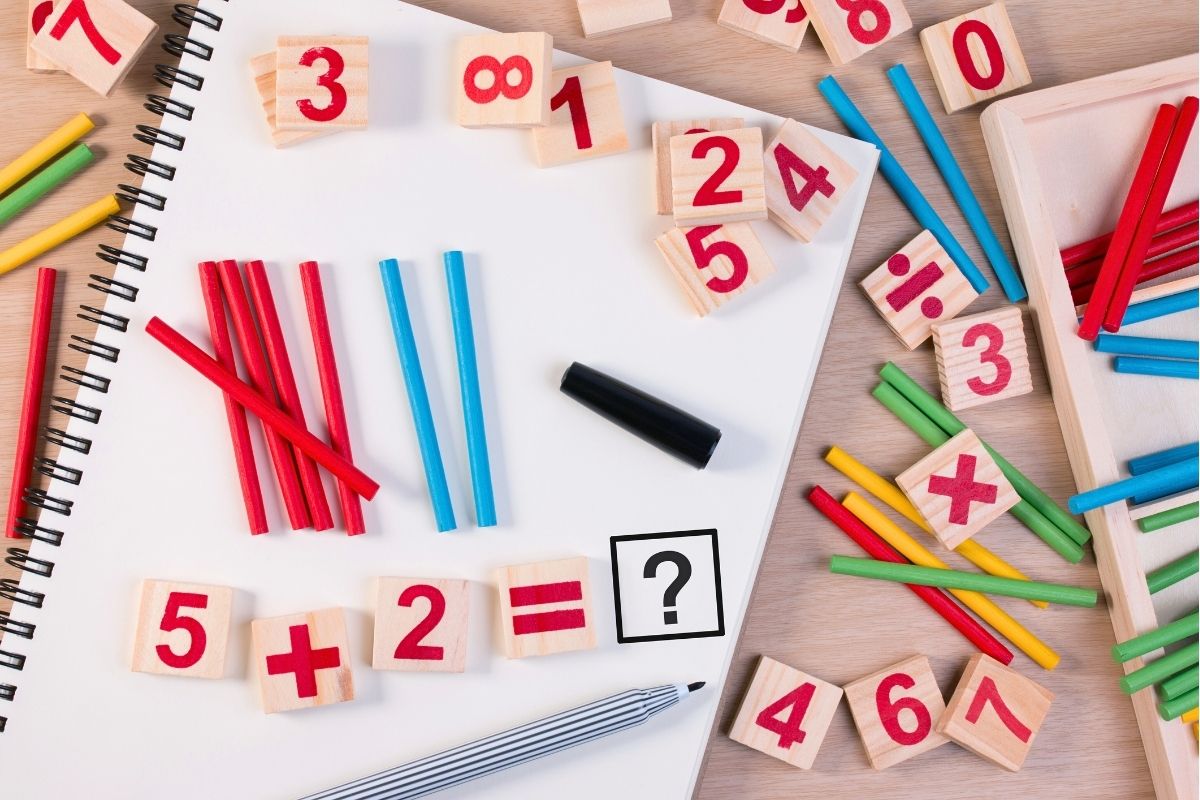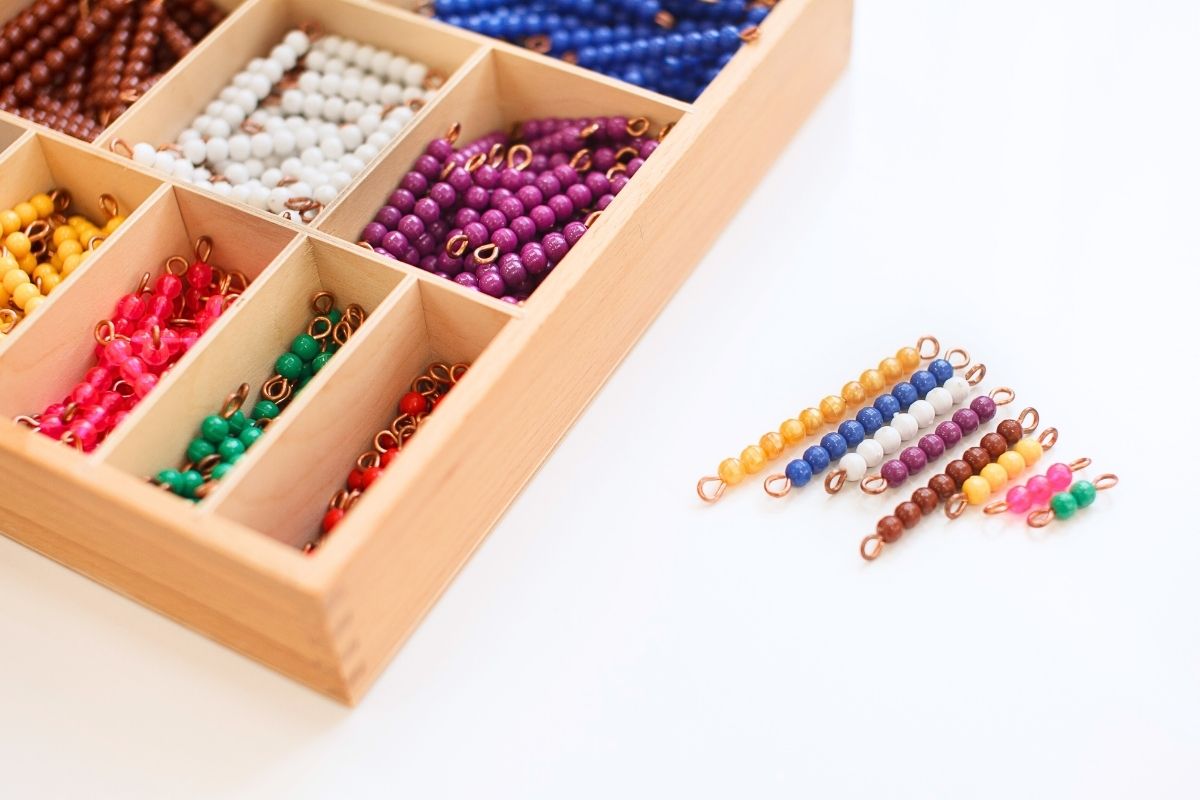The art of teaching mathematics, specifically count and skip counting, can be daunting. This is where the Montessori Method shines. The Montessori approach makes learning math fun, interactive, and more understandable for children. It uses hands-on learning materials like bead chains, number cards, and various printables to make the learning process more effective.
The Montessori Approach to Mathematics
The Montessori Method, developed by Maria Montessori, is a child-centered educational approach that encourages children to learn through their own initiative and natural activities. It offers a broad vision of education that focuses on the cognitive, social, and emotional development of a child.
When it comes to mathematics, the Montessori Method emphasizes hands-on exploration and discovery. It uses a variety of specially designed materials, like colorful bead chains, numerals, and cards, to help children visualize mathematical concepts and construct their understanding.
What is Skip Counting
Skip counting is a method of counting numbers where instead of increasing by one, you “skip” or “jump” by another number. For example, skip counting by twos would be: 2, 4, 6, 8, 10, and so on. It’s essentially counting by multiples of a certain number.
Presentation of Skip Counting
Skip counting can be visually presented using number lines, bead chains, or even by hopping on a number floor mat. The idea is to show the child the pattern of numbers they are skipping. For instance, when skip counting by fives, you’d highlight or count every fifth number: 5, 10, 15, 20, and so on.
Purpose of Skip Counting
- Foundation for Multiplication and Division: Skip counting lays the groundwork for understanding multiplication and division. For instance, counting by threes (3, 6, 9, 12…) is essentially understanding the multiplication table of three.
- Enhances Number Sense: It helps children recognize patterns in numbers, aiding in their overall number sense and mathematical intuition.
- Efficiency: Skip counting is a faster method to count groups of items without counting each one individually.
- Enhances Memory: Repeatedly practicing skip counting helps in memorizing number sequences, which is beneficial for mental math.
How to Introduce Skip Counting to Children
Skip counting is typically introduced to children between the ages of 4 to 6. However, the exact age can vary based on the child’s readiness and prior exposure to numbers.
- Use Real-life Objects: Start with tangible items like fruits, toys, or beads. Group them and count them in twos, threes, or whichever number you’re focusing on.
- Songs and Rhymes: There are many children’s songs and rhymes that incorporate skip counting, making it a fun and memorable activity.
- Number Lines: Draw a number line and let the child hop or mark every second, third, or fourth number, depending on the skip counting sequence you’re teaching.
- Bead Chains: In the Montessori method, bead chains are a popular tool for skip counting. Children can lay out bead chains and count by twos, threes, etc.
- Games: Incorporate skip counting in games. For instance, playing hopscotch where they hop every two or three squares.
- Flashcards: Use flashcards with numbers. Show them every second or third card to visually represent the skip counting sequence.
Best Montessori Math Materials for Skip Counting
| Material | Description | Purpose | Age | School Level | How to Use |
|---|---|---|---|---|---|
| Bead Bars | Sets of beads, each bar ranging from 1-10 beads. | Visual representation of skip counting sequences. | 4-5 years | Pre-Kindergarten | Combine different bars, e.g., two bars of five beads each for the number ten. |
| Bead Chains | Sequences of colored beads, e.g., a chain of two beads repeated ten times. | Visual representation of skip counting patterns. | 5-6 years | Kindergarten to 1st Grade | Lay out in sequences, counting by twos, threes, etc. |
| Bead Stair | Sequence of colored bead bars from 1-10. | Colorful exploration of number sequences. | 4 years | Pre-Kindergarten | Arrange in sequence; practice skip counting by picking every second or third bead bar. |
| Hundred Board | 10×10 grid board with tiles numbered 1-100. | Represents number sequences and patterns. | 4-6 years | Pre-Kindergarten to Kindergarten | Place tiles in sequence; for skip counting, place every second, third, or fifth tile. |
| Long Chains | Extended bead chains beyond 10, up to 100. | Advanced skip counting and multiplication exploration. | 6-7 years | 1st to 2nd Grade | Lay out and practice skip counting, e.g., count by threes with a chain of 30 beads. |
| Short Chains | Bead chains of lengths 1-10. | Tactile representation of numbers, aiding in linear counting. | 4-5 years | Pre-Kindergarten | Lay out from shortest to longest, counting beads. |
| Snake Game | Bead chains used to form ‘snakes’. | Hands-on teaching of addition. | 5-6 years | Kindergarten to 1st Grade | Create ‘snakes’, then change them into golden chains by counting and exchanging beads. |
| Strip Board | Board with colored strips representing numbers. | Concrete visualization of skip counting. | 5-7 years | Kindergarten to 2nd Grade | Place strips in sequence for skip counting, e.g., two strips of two for the number four. |
Teaching Skip Counting Using Montessori Bead Chains
One of the most effective tools for teaching skip counting in a Montessori setting is the bead chain. These chains consist of beads linked together in a chain, representing units of numbers.
For instance, a chain of 5 will have five sets of five beads each. As the children count the beads, they strengthen their understanding of the multiples of five. Encourage the children to count aloud as they move their fingers along the chain. This way, they can see, feel, and hear the numbers, creating a multi-sensory learning experience.
To further reinforce the learning, children can match the bead chains to corresponding number cards. This helps them associate the physical chain with the abstract concept of numbers.
Incorporating Montessori Math Cards and Printables
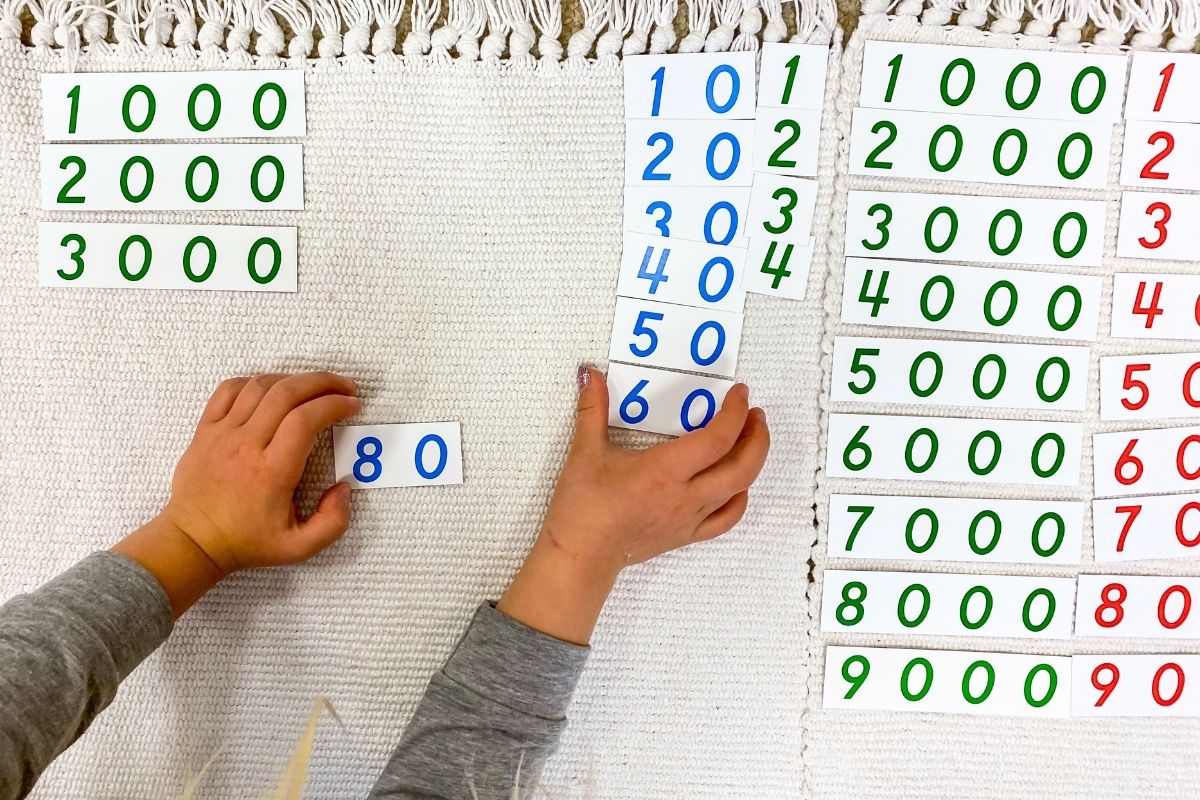
Montessori math cards and printables are other exceptional tools to teach skip counting. Number cards can be used in conjunction with bead chains. After counting the beads, children can match the number of beads to the corresponding card. This reinforces the relationship between the physical object and the abstract number.
Printables, on the other hand, provide a variety of activities that can be tailored to the children’s learning pace. They can include fill-in-the-blank exercises, coloring sheets, or pattern recognition activities. These activities allow children to practice skip counting while reinforcing the concept through repetition and variation.
Activities for Skip Counting: Addition, Multiplication, and Beyond
After mastering the basics of skip counting, it’s essential to further nurture a child’s mathematical journey with more intricate activities. These can encompass games and exercises that intertwine the concepts of addition and multiplication, all rooted in the foundational principles of skip counting.
For a hands-on experience, children can use bead chains or number rods to skip count by specific intervals, such as fours or fives. By doing so, they can visually and tangibly see how counting by fours, for example, aligns with the act of multiplying a number by four.
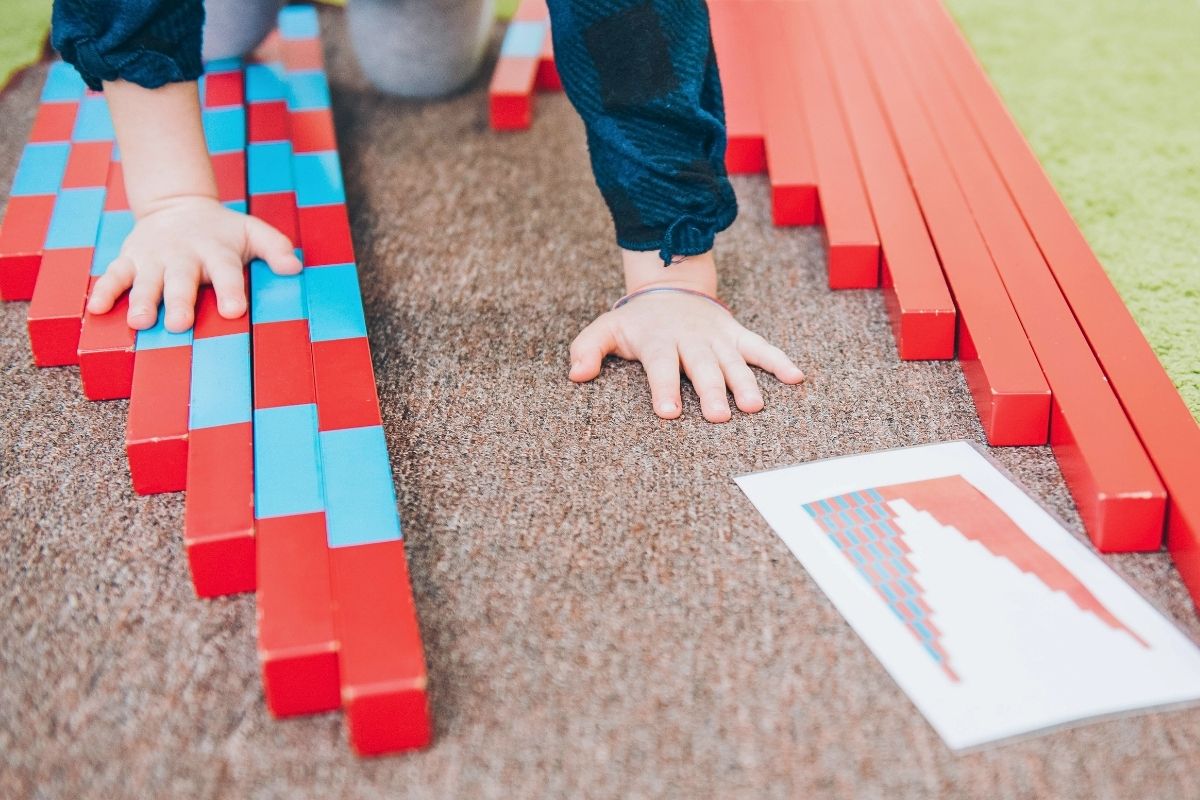
Another engaging activity involves using the Montessori hundred board. Children can place tiles on every second, third, or fifth square, for instance, to visualize the patterns of even numbers or multiples. This not only reinforces skip counting but also introduces them to the patterns inherent in multiplication.
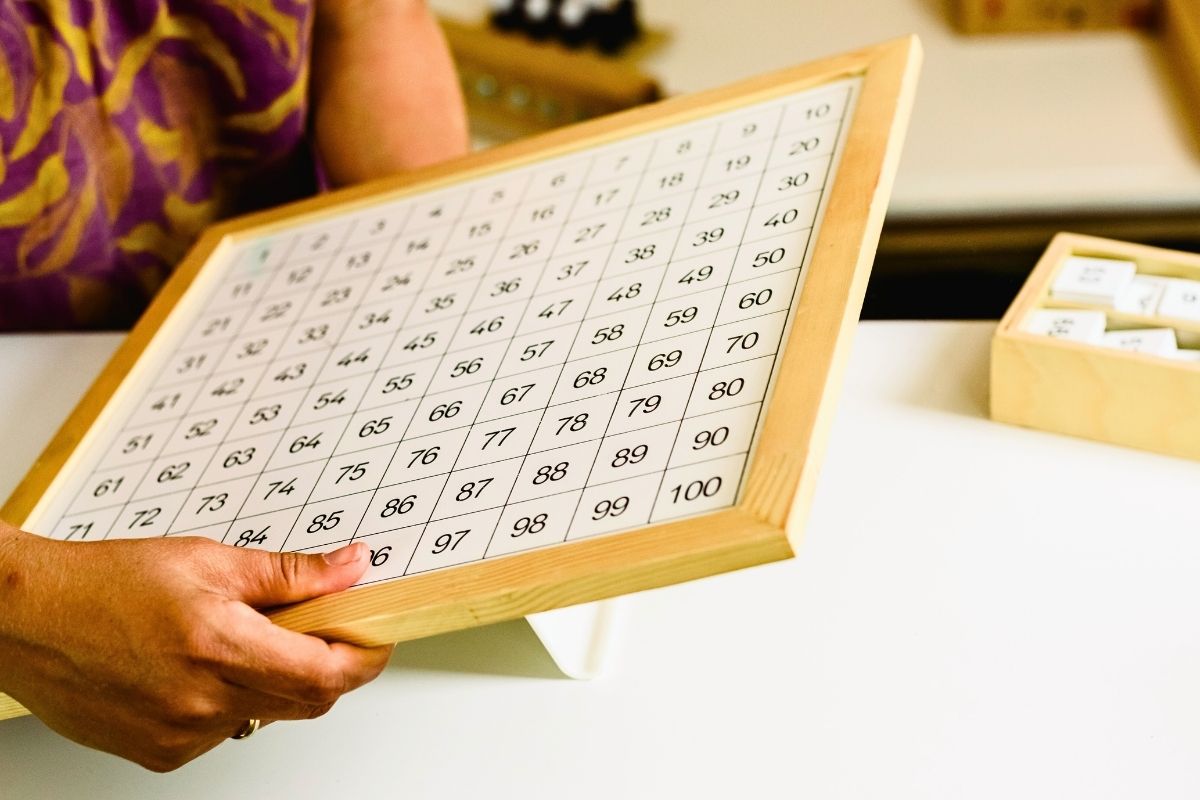
Furthermore, interactive games can be introduced where children group items in sets (like grouping apples in sets of two or three) and then count the total number of items using skip counting. This activity seamlessly blends the concepts of addition and multiplication, emphasizing their interconnected nature.
By intertwining skip counting with these additional activities, children not only solidify their understanding of numbers but also pave the way for grasping more complex mathematical operations in the future.
Montessori Snake Game and Strip Board Activities for Skip Counting
Moving forward with the Montessori method, two engaging activities that children can enjoy are the Snake Game and the use of a Strip Board. Both activities, inspired by Montessori, serve to strengthen a child’s understanding of skip counting, fostering a better connection with numbers and their relationships.
Montessori Snake Game
The Snake Game is a dynamic activity that uses colored bead chains—both short and long—to teach addition and subtraction in an engaging manner.
- In the Addition Snake Game, children create a ‘snake’ with the bead chains, then ‘change’ the snake into a golden bead chain by counting and exchanging beads. This game allows children to visualize the concept of addition and see the results of their counting.
- The Subtraction Snake Game follows a similar concept but focuses on removing beads to understand subtraction. For instance, a snake of four short bead chains of two beads each can be changed into one long bead chain of eight beads, demonstrating that 2+2+2+2 equals 8.
Montessori Strip Board
The Strip Board offers another tactile experience. It’s a wooden board equipped with colored strips representing numbers. The Addition Strip Board and Subtraction Strip Board are tools that make arithmetic operations concrete. For example, when a child places a strip marked ‘2’ next to another strip marked ‘2’ on the Addition Strip Board, they can physically see that 2+2 equals 4. Conversely, the Subtraction Strip Board helps them understand how numbers reduce when subtracted.
Together, these Montessori math materials provide children with a comprehensive, interactive, and enjoyable foundation in arithmetic, ensuring that they grasp the core concepts in a meaningful way.
How Montessori Math Creates a Concrete Understanding of Skip Counting
The Montessori curriculum to teaching skip counting offers a transformative education experience. The hands-on materials make learning a tangible and interactive process. Montessori math material and activities tap into a child’s innate curiosity and desire to learn. They assist children in understanding and visualizing the patterns and relationships between numbers, thereby enhancing their number sense, fluency, and adaptability in mathematical thinking.
These methods are not only engaging but also effective in helping a child learn and comprehend more complex mathematical concepts. They help the child form a solid understanding of skip counting, which is a crucial stepping stone towards mastering higher-level computations like multiplication and division.
Indeed, the Montessori method turns the daunting task of teaching and learning mathematics into a fun, interactive, and comprehensible journey. As Maria Montessori once put it, “The goal of early childhood education should be to activate the child’s own natural desire to learn.” This is precisely what Montessori math accomplishes with skip counting, making it an integral part of a child’s education journey.

